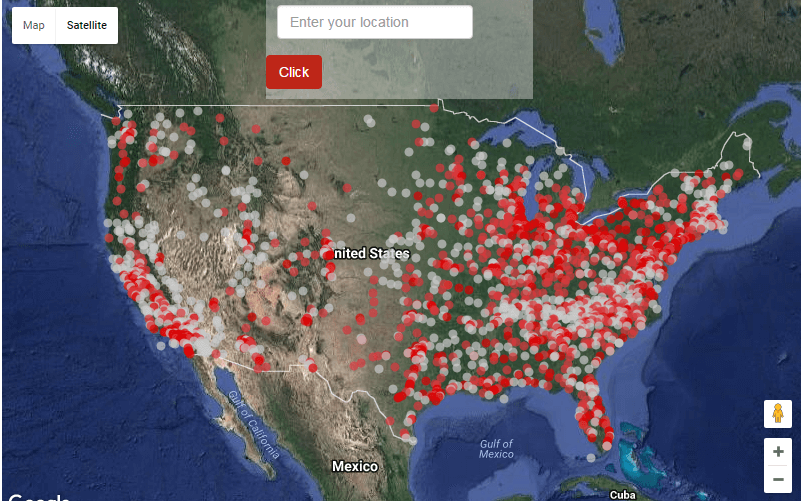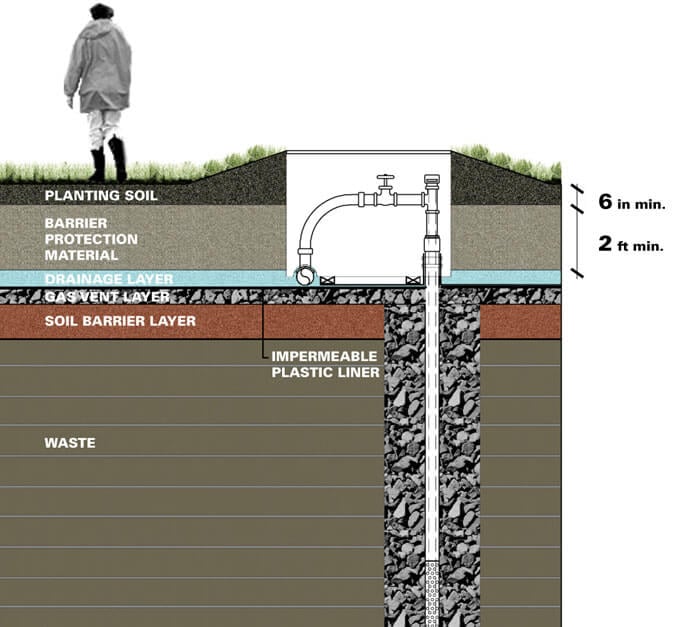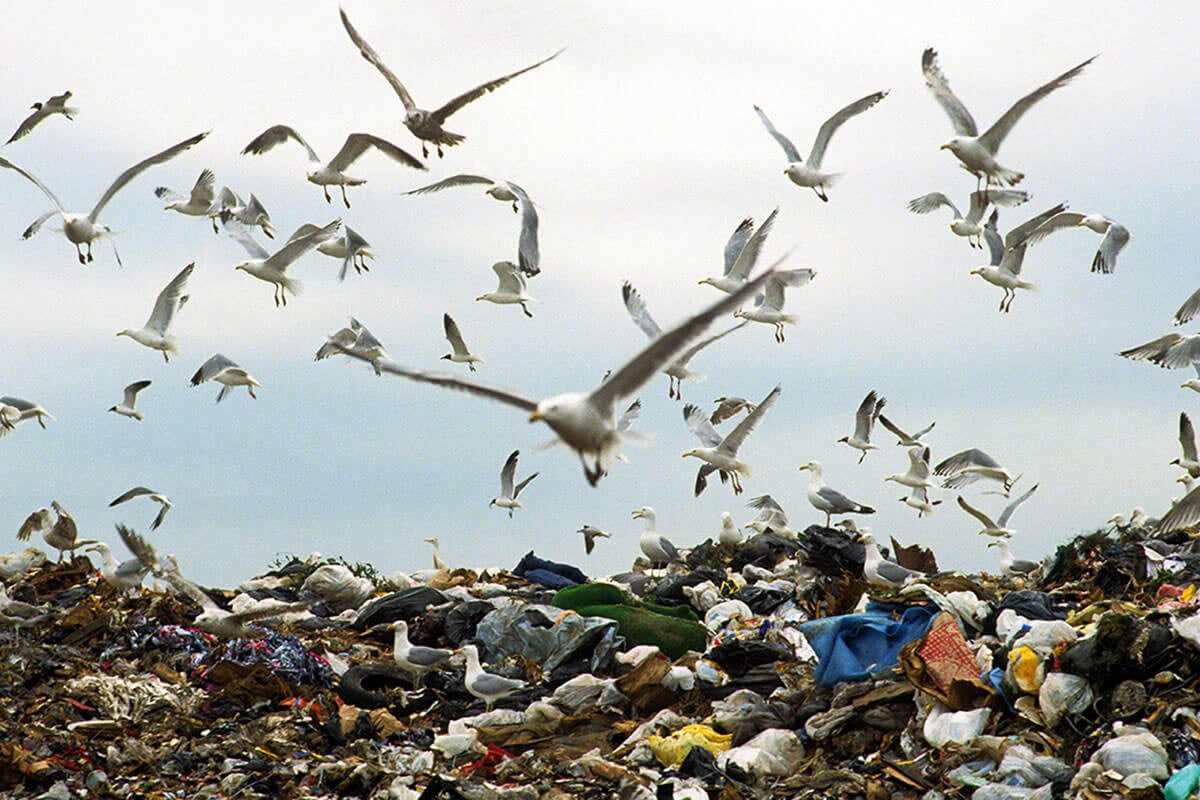Landfills are everywhere yet many of us don’t even know that some old timey dumps may be right beneath our feet. In modern times, communities do whatever they can to push these as far out into the sticks as they can. “Not in my backyard” they cry! But how do these massive pieces of infrastructure work and what happens to them when we’re done tossing trash into them?
During our time in the waste industry, we’ve realized that a lot of dump sites were built prior to 1976 when the Resource Conservation and Recovery Act (RCRA) was instituted. RCRA set the standard for how to handle certain wastes, and what sprang from that were requirements on how to properly build and maintain a landfill. Old dumps are scattered about many of our communities without us even knowing. Engineering firms and local governments monitor these sites and even approve many of them to be redeveloped into parking lots, retail, and if stable enough, housing. Maybe that crack in your parking lot at work was created from some slowly decaying construction waste from the 1960s.

New York City has invested almost one billion dollars to convert the famous Fresh Kills landfill into parkland. During its heyday, Fresh Kills was the largest landfill on Earth, taking in 29,000 tons of trash per day (a typical collection truck maxes out at about 10 tons of trash). Twenty years after its closure, the city is still working on redeveloping the site and it got us wondering what the best uses of these old landfills are, and what the opportunities may be for this aspect of the waste and recycling industry.
The Less Expensive Options
Bikes and Disc Golf
There are plenty of lower capital investments a community can make with one of these sites. One of our favorite descriptions of a bike trail at a former landfill site can be found here…sounds charming. One of the most highly regarded disc golf courses in the world is in Stockholm… also a former landfill and no one seems to mind.
Golf
With so much land, developers can get some pretty cheap deals for their dollars by choosing to cover a landfill with a golf course. Sure, the rolling hills and sand traps shift constantly due to decomposing material beneath. And the methane exhaust may fart a few times during your round, but generally you won’t even notice. Trees can’t typically be planted because their roots could damage the cap liner of the site. Drainage and irrigation lines may pop and cart paths may break apart due to shifting…but how else do you fit a new golf course within Chicago city limits?
Here’s a list of golfing hot spots you can give your dad to hit up. Tell him to watch out for any methane exhaust as he’s going for eagle.
- Trinity Forest (Dallas) designed by https://www.cooreandcrenshaw.com/
- Trump Golf Links at Ferry Point by Jack Nicklaus
- TPC Scottsdale Stadium Course
- Harborside in Chicago
Getting some money off this land
Solar fields
Landfills close and you cover them with solar panels. Seems like a no brainer. A 240 acre landfill equals about 5,000 homes powered. Boom. Based on an RMI brightfield analysis from late 2021, closed landfills could host more than 60 gigawatts of solar capacity which would power the entire state of South Carolina.
As landfills take 50+ years to fill up, the surrounding neighborhoods are impacted severely- reserved mostly for the population that can’t afford to move away. Constant trucks driving by, dust clouds swept into the sky, seagulls and other critters and obviously the odor are just a few items that can negatively impact a lifestyle. Environmental justice concerns can be somewhat assuaged once the landfills close and new solar sites installed. This redevelopment brings high skill jobs to areas often greatly in need of revitalization but certainly a high price to pay.
Landfill mining
There’s gold in them there hills!! Well, maybe 30 million tons of aluminum scrap.
Hotly debated with few example projects to analyze, landfill mining is an unknown at this point. The most successful projects have involved mining of ash landfills with larger quantities of metals. In the past, many waste-to-energy facilities did not recover metals from their process, so landfill miners can often find metals recovery in the sites that were dedicated to those former ‘ashfills’.
The second major benefit is added airspace. Airspace is the permitted volume of waste allowed to be placed within the landfill. These permits are established by local and state regulators. Being able to add a few years to a landfill’s permitted capacity is a major economic opportunity, allowing the landfill owner and operator to amortize costs associated with equipment and landfill closure over a longer term.
These efforts can free up airspace for additional waste tonnage, or they can free up land for development. Certain states and countries have restrictions on building on top of a landfill, but it can be done. Just watch where you step.
The return on investment from other material streams is pretty low- there’s not a market for dirt-filled paper or plastics. These materials could be screened to remove some organics and dirt- this dirt/organics mixture being re-used onsite as alternative daily cover (ADC).
ADC is a common tool among many landfills. Instead of using soil, ADC can be utilized as the ‘cap’ layer after each workday at the landfill. This layer prevents material from flying away into the environment and also allows for a medium for landfill gas capture pipes and leachate management systems. By opening up this layer to access material beneath, unknown quantities of methane could also be released into the atmosphere.

So how does one actually mine a landfill? Here are two process ideas:
Identifying an older waste to energy plant that sends their material to an ‘ashfill’ is probably a good place to start. Many older facilities may not have equipped their system with post-processing metals extraction…so perhaps there are a few pennies in those ashes.
Often in Europe, waste is needed to power electrical plants. Many countries in the EU tout a zero-waste mantra, but in essence, they convert a high percentage of their waste into energy (WTE) (especially in Scandinavia). This allows the landfills to be bypassed in favor of WTE plants…and could even drive further landfill mining on the continent since landfills need to be utilized as a ‘last resort’ for special wastes. In the USA there’s not a thriving waste to energy market except in states like Florida. If a waste to energy facility is nearby, this could certainly help offset some costs. Interested in learning more about waste to energy? Look up www.wtienergy.com and www.covanta.com.
The complementary option to all of the above
Landfill gas: powering your home with trash
As they say, a bird in the hand is almost as good as not having hundreds of seagulls swarming around your giant waste pile on the way to work. It’s true, the seagull is nature’s garbageperson…and they love the buffet at your local landfill. But while that pile of garbage is sitting there for the next several millennia, why not extract some value from it?
Landfill gas capture is standard in modern landfills but we still have a long way to go to ensure all landfills can harness this energy and not just pump it into the atmosphere. In 2022, municipal solid waste has been calculated to represent 11% of the total methane emissions on the planet. The Puente Hills Landfill in Los Angeles County reports that the power it can generate would be enough to power 70,000 homes. The link and image below would lead us to assume the largest plants in the US could power millions of homes by themselves.
Source: https://findenergy.com/power-plants/landfill-gas/
Landfill gas is captured via a complex system of pipes and fans within the landfill itself. The gas collected is mostly methane which is produced when organic matter decomposes in an oxygen-less environment. Once collected, the methane is combusted within boilers to create steam. The super-heated steam turns turbines to create electricity which is then sent to the energy grid.
Gas is captured during the entire lifecycle of the landfill. Since various parts of the landfill are capped when full and other parts of the landfill continue to be filled, it’s a gift that keeps on giving. While this gas continues to be produced, modern landfills are a beneficial complement to other methods of non-fossil fuel energy sources. There’s a debate about how efficient these landfill gas capture systems are, but recently there has been a much larger push from private companies and the US government to capitalize on this energy source.
Many stakeholders such as large utilities enjoy the environmental benefits they can tout by using this electricity within their grids, while large transportation companies pursue this energy stream to power their fleets. The huge oil and energy company Kinder Morgan has been on an acquisition streak of landfill gas projects, dropping $135M in August 2022 to buy North American Natural Resources. UPS claims to have driven 3 billion miles on alternative fuels and WM (formerly Waste Management) plans to plow $800M+ into landfill gas capture to fuel their entire fleet from waste to fuel.
In a game-changing announcement in May 2022, Republic Services announced a $1.1 billion partnership with Archaea Energy to convert 30 landfill sites to Archaea’s landfill gas extraction and conversion technology. This allows trucks to be fueled, houses to be energized and renewable energy credits to be sold to other companies needing to offset their carbon emissions.

Our newest favorite, though, is the startup, Vespene Energy, now powering their Bitcoin mining operation from landfill gas. Here’s an interesting viewpoint of their approach via a thread on Twitter.
Whether it generates energy or gives your stepdad a place to chip and putt, landfills need to be cared for and put to their best use. They are a major part of our infrastructure and often the poorest among us bear the brunt of their downsides. However, the world of landfills is generating many technical jobs and as more innovation comes to the space…whether through landscape architecture, scanning methane leaks from space, developing energy distribution projects or even studying archaeology, it is expected to be a solid place of career growth for the long term.
Check out the latest Recyclesaurus jobs not destined for the landfill, unless of course, they require you to work at a landfill.